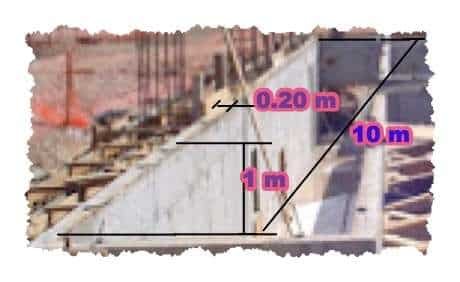 Standard man hours for Civil works. Fast calculation of working hours required to complete reinforced concrete structures.
Standard man hours for Civil works. Fast calculation of working hours required to complete reinforced concrete structures.
Worker Hours Calculation
Worker Hours Calculation. To perform this type of estimate, we will analyze the performance of the following activities:
- Time for manufacture and fill concrete.
- Construction and assembly time of formwork.
- Cutting, folding and mounting time of the reinforcement.
Note: The times given in this publication apply to small works.

Standard man hours for Civil works. Reinforced concrete structures
- Task: Prepare concrete and its subsequent pouring into the structure.
- The yields indicated below are conservative and valid for structures at the ground level.
- Efficiencies for filling structures, with manual preparation and transfer of concrete equal to 8 hours of work x m3.
- Same here, but for plates equal to 6 men hours x m3.
- In the case of a concrete production factory installed on site and transported by mixing trucks, the performance is 1.5 man hours x m3.
- Task: Production and assembly of wood formwork.
Here we should first know the coefficient that connects the wet formwork m2 with the concrete m3 that fills the structure, we call this ratio A.
Formula – Wet formwork/ m3 of concrete
A = m² of wet formwork/ m3 of concrete.
We underline that A is a coefficient that varies with the type of structure.
Continuing the calculation, we will divide the preceding coefficient by the time it takes to build and assemble a m2 of formwork.
For formwork where the boards are manufactured and reused, there be a performance for this job of 0.80 m2 of formwork per hour, we call this value B.
If the formwork boards are only produced for a given structure and are not reused, the performances fall to 0.35 m2 of formwork per hour, which we call C.
Formula – Production and mounting time of the formwork per m3 of concrete
The fabrication and assembly time of the formwork per m3 of concrete is:
Reusable formwork time = A/B = wet formwork m2/ m3 of concrete, divided by 0.80 m2/h.
Single-use formwork time = A/C = wet formwork m2/ m3 of concrete, divided by 0.35 m2/h.
Formula – Cutting, bending and assembly of the armor
- Task: Cutting, bending and assembly of the armor.
In this case, we must know how many kilograms of iron we will use in the concrete structure, we identify it with the letter D.
Next, we divide the kilograms of iron that are cut, bent, and assembled per hour, by performing this task, which is 10 kg per hour, which we refer to E.
Division D of E.
Runtime = Kg of iron divide by 10kg/h.
Standard Conditions
The yields used for this calculation of working hours, meet the following Standard Conditions:
- The Works site is isolated and the performance of the Works is independent of another operating installation.
- This is a small job.
- The tasks are performed in a moderate climate (mean temperatures between 5°C and 30°C) with winds of less than 30 km/h.
- The area in which the work is conducted is free from contamination.
- Work takes place in daylight hours.
- Work is carried out in an area where the ground is flat and dry.
- Maximum height of work surface not to exceed 1.50 m above ground level.
- Minimum clearance in covered spaces equal to 2.60 m.
- Maximum transport distance from the storage or unloading area to the construction site is 300 m.
- The operator’s access door is within 200m of the work area.
- Technical deliverables and supplies are received in accordance with the project timeline.
- Trained fieldworkers are available.
- Suitable construction equipment and tools are available.
- The work site is at a height near sea level so that the altitude of the place does not require additional effort from the workers.
- Performance do not include:
- Assembling and removing scaffolds.
- Rebuild work due to design mistakes.
- Surveying, inspection and checking work.
- Excavating and subsequent filling.
- Execution of concrete cleaning.
- Labor for curing concrete.
- Disassembly and cleaning of formwork.
- Time spent cleaning and removing remaining materials and equipment on site.
Using the above data, we will calculate how many hours of work it takes to build a reinforced concrete wall, like the one in the figure,
Data to be used for example calculation
- The concrete is produced manually.
- The wall is 1 m high and 0.20 m thick.
- The amount is 90 kg of iron per m3 of concrete.
Fast calculation of working hours
Time used for concrete manufacturing and filling = 8h x m3.
Time spent in manufacturing and assembly of the formwork.
(Here, the boards are made and then reused)
For this structure, the m2 of formwork per m3 of concrete are calculated according to the next figure.

Person-hours calculation example
That is, for 2 m3 of concrete, the wet formwork is = 1 x 10 x 2 = 20 m2.
For 1m3, it is 10 m2 = A.
In this example, formworks are re-used, so we use:
B = 0.80 m2 x h.
Then A/B =12.50 h x m3.
Time spent constructing and assembling the Armor.
The quantity is D = 90kg. x m3 of concrete.
Performance is E= 10 kg. x h.
D/E = 9 h x m3.
To obtain the number of the fast calculation of working hours, we add the previous values, that is:
8 + 12.50 + 9 = 29.50 h x m3.
To this value, we need to add variable times depending on the type of work we discussed above.
Standard man hours for Civil works – Calculate Man Hours.